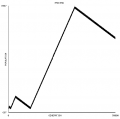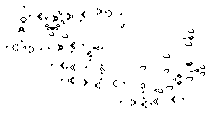Hacksaw
Hacksaw is an orthogonal sawtooth with expansion factor equal to 9 that was found by Dean Hickerson on August 7, 1992. The population in generation t = 385(9n) - 189 (n ≥ 1) is t/4 + 1079, but the population in generation 1155(9n - 179) (n ≥ 0) is only 977.
| Hacksaw | |||
| |||
| View static image | |||
| Pattern type | Sawtooth | ||
|---|---|---|---|
| Number of cells | 687 | ||
| Bounding box | 199×102 | ||
| Expansion factor | 9 | ||
| Discovered by | Dean Hickerson | ||
| Year of discovery | 1992 | ||
| |||
The pattern consists of two parts, a stationary shotgun and a set of puffers moving east. The shotgun produces, and usually destroys, a salvo consisting of a middleweight spaceship and two lightweight spaceships. The moving part consists of a blinker puffer 1 and two period 24 glider puffers whose output gliders destroy each other (with help from an accompanying middleweight spaceship). In generation 385(9n - 189) (n ≥ 1) (and 228 for n = 0), a salvo hits the back end of the row of blinkers, causing it to form a blinker fuse that decays at 2c/3. When the row is completely gone, a new row starts to form and a spark is produced. The spark is turned into a glider by an accompanying heavyweight spaceship; the glider is turned into a westward lightweight spaceship in generation 1155(9n - 127) (n ≥ 0) by interacting with the glider puffers. The 3-glider synthesis of the lightweight spaceship is due to David Buckingham. When the lightweight spaceship hits the shotgun in generation 2310(9n - 184) (n ≥ 0), another salvo is released, starting the cycle again.
The idea for this sawtooth pattern was suggested by Bill Gosper.
Image gallery
 The number of alive cells plotted versus the number of elapsed generations roughly forms an ever-increasing sawtooth graph.
The number of alive cells plotted versus the number of elapsed generations roughly forms an ever-increasing sawtooth graph.
Videos
See also
External links
- Hacksaw at Dean Hickerson's webpage
